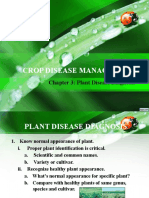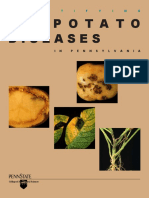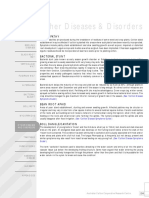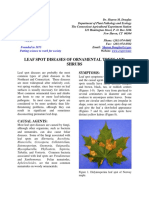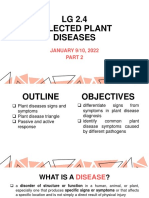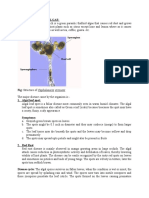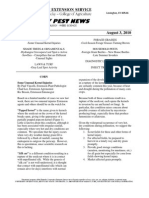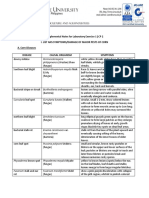Professional Documents
Culture Documents
Cotton Diseases
Cotton Diseases
Uploaded by
chvenkiCopyright
Available Formats
Share this document
Did you find this document useful?
Is this content inappropriate?
Report this DocumentCopyright:
Available Formats
Cotton Diseases
Cotton Diseases
Uploaded by
chvenkiCopyright:
Available Formats
Diagnosis and Management of Foliar Diseases
of Cotton in the United States
Bobby Wade1, Robert Kemerait1, Jason Brock 1, Austin Hagan2, Kathy Lawrence2, Paul Price3, Tom Allen4,
Travis Faske5, Terry Kirkpatrick5, Nick Dufault6, Heather Young-Kelly7, Hillary Mehl8, Tom Isakeit9,
Terry Wheeler9, Jason Woodward9, John Mueller10, Robert Nichols11
1
University of Georgia, 2Auburn University, 3Louisiana State University, 4Mississippi State University, 5University of Arkansas,
6
University of Florida, 7University of Tennessee, 8Virginia Tech, 9Texas AgriLife Extension Service, 10Clemson University, 11Cotton Incorporated
Name: Ascochyta Blight (Wet Weather Blight)
Caused by: Ascochyta gossypii (Phoma exigua)
Foliar Symptoms: Ascochyta Blight forms lesions on cotyledons, leaves,
stems, and bolls. Lesions on the cotyledons and leaves approach 2 mm (<0.1
in) in diameter, are white to light brown and circular in shape. Elongated can-
kers on the stem are reddish-purple to black or ash gray in color. Small, black
fruiting structures are likely to be embedded in symptomatic tissue.
Management: Use fungicide treated
seed, avoid planting in cool wet
weather, and incorporate cotton res-
idue to encourage decomposition,
which helps in fields with a history of
Symptoms of Asochyta Blight on cotton leaf. Note
Ascochyta Blight. dark border and also small, embedded fruiting struc-
Diagnostic Note: Margins of necrotic tures in the spots.
regions on leaves and cotyledons will have dark borders. Spots may have a
target-like appearance. However, Ascochyta Blight typically occurs early in the
season and small black fruiting structures are observed in the lesions.
Early-season symptoms of Ascochyta Blight on coty- Range and Yield Loss: Ascochyta Blight has been reported in most major
ledons of cotton. (Photo credit S.M. Brown). cotton producing regions. Yield loss is rarely reported, but is possible under
conditions such as prolonged cloudy weather with cooler temperatures and rainfall.
Name: Bacterial Blight
(Angular Leaf Spot, Black Arm)
Caused by: Xanthomonas citri pv
malvacearum
Foliar Symptoms: Symptoms of Bacte-
rial Blight start as tiny water-soaked
spots, and progress into characteristi-
cally angular shapes due to leaf veins
limiting bacterial movement. Lesions
appear on the upper side of the leaf,
turn black as they expand, and defoli-
ation may occur. Systemic infections
Note angular shape and dark brown color of lesions Sunken lesions resulting from Bacterial Blight.
and petiole damage of Bacterial Blight. follow the main veins as black streaks;
symptoms on the bolls are characteristically sunken, water-soaked lesions.
Management: Resistant cultivars are the most economical option to minimize
yield loss. Incorporation of infected residue into the soil will help with decom-
position of infected debris and reduce inoculum in the soil.
Diagnostic Note: Lesions are typically dark brown (darker than many other
pathogens) and can be “shot-hole” in appearance when necrotic tissue falls
away. Observe the underside of the leaf for water-soaking around the lesions.
Range and Yield Loss: Bacterial Blight is a major disease of cotton. Since acid
delinting of cottonseed in the U.S., Bacterial Blight has been rare, except in OK
and TX; however, there is a recent resurgence in additional states. Yield loss Close-up of lesions of Angular Leaf Spot. (Photo
can be severe, up to 20%, depending on variety and pathogen race. credit: Tom Allen)
Name: Target Spot
Caused by: Corynespora cassiicola
Foliar Symptoms: Characteristic
symptoms of Target Spot include
brown lesions, sometimes approach-
ing 2 cm (~1 inch) in diameter, exhib-
iting a series of concentric rings. Un-
like Stemphylium and Alternaria Leaf
Spot, the spots are typically not bor-
dered by a dark band. Leaf spots and
premature defoliation are generally
confined to the interior canopy
Typical spores of Corynespora cassiicola, causal
(unlike that found in Stemphylium
agent of Target Spot.
and Alternaria diseases.)
Management: Management of Interior defoliation commonly observed with Target
Target Spot with fungicides is made Spot.
difficult by the dense canopy which obstructs placement of fungicides in the
interior of the canopy. Greatest success in managing Target Spot has been
achieved by applying fungicides during the 1st and 3rd weeks of bloom.
Diagnostic Note: Target Spot can be quickly differentiated from Stemphylium
Leaf Spot by location in the canopy. Also, defoliation from Target Spot
typically begins at the bottom of the plant and progresses upwards. Lesions
may occur on the upper canopy, but defoliation of the upper 20% has not
been observed.
Typical symptomatic lesion of Target Spot.
Range and Yield Loss: Target Spot has become progressively more wide-
spread in the Southeast and Mid-South regions of the Cotton Belt, but is most severe in Florida, Alabama and Georgia.
In severe cases, yield losses exceeding 200 lbs lint/A have been documented.
Name: Cercospora Leaf Spot
Caused by: Cercospora gossypina,
Mycosphaerella gossypina
Foliar Symptoms: Reddish lesions will
occur during the early stages. As the
disease progresses, the lesions en-
large and turn white to light brown in
the center. The lesions are circular
and vary in size. Concentric zones are
often present with a red color at the
Cercospora lesions on cotton leaf
margins.
Management: Maintaining plant vig-
or by having proper fertility and pre-
venting drought stress through irriga-
tion helps delay primary infections
and reduce the severity of disease
outbreaks.
Diagnostic Note: In the field it is often
difficult to differentiate Cercospora Foliar symptoms of Cercospora Leaf Spot. (Photo
credit J. Brock)
Tapered cylindrical spores of Cercospora gossypina. Leaf Spot from other foliar diseases.
The spots appear concentric, like those of Target Spot, and the general distribution of spots on the plant may be the
same as Stemphylium Leaf Spot and Alternaria Leaf Spot. Correct diagnosis often requires viewing the long, thin whip-
like, septate spores. Caution should be taken as C. cassiicola spores can appear similar to Target Spot, but typically are
broader and may have a basal scar.
Range and Yield Loss: Cercospora Leaf Spot occurs in all cotton producing areas within the U.S. When Cercospora Leaf
Spot occurs while plants are under stress, or in a disease complex with Alternaria or Stemphylim Leaf Spot, premature
defoliation, reduced yield, and lower fiber quality have been documented.
Name: Alternaria Leaf Spot
Caused by: A. macrospora, A. alternata
Foliar Symptoms: Alternaria Leaf Spot forms lesions on
senescing leaves that are brown with purple margins. As
they expand they typically exhibit concentric zonation and
the necrotic tissue will overlap with other lesions. As the
disease progresses the lesions will become gray and dry
with some of the necrotic tissue falling out giving it a “shot
-hole” appearance.
Management: Reducing plant stress and insuring proper
soil fertility, especially with potassium, can reduce disease
severity.
Diagnostic Note: Symptoms of Alternaria Leaf Spot and
Stemphylium Leaf Spot are similar; however Alternaria
Leaf Spot is more
commonly ob- Foliar symptoms of Alternaria leaf spot. (Photo credit J.E. Woodward)
served in Texas
and the Mid-South and Stemphylium Leaf Spot in the Southeast. Lesions with
concentric rings may appear similar to Target Spot; however spots from
Alernaria Leaf Spot will be throughout the canopy and are also associated with
reddening and yellowing leaves.
Range and Yield Loss: Alternaria is one of the most common cotton diseases
and is associated with late season cotton development. (Note: Alternaria Leaf
Spot and Stemphylium Leaf Spot are similar in that both are most severe when
cotton plants have insufficient potassium, either from inadequate fertilization
or during periods of drought.) Yield loss is not considered a problem with Al-
Cotton field in Texas severely affected by Alternaria
leaf spot. (Photo credit J.E. Woodward)
ternaria Leaf Spot if symptoms and defoliation occur late in the season.
Name: Stemphylium Leaf Spot
Caused by: Stemphylium solani
Foliar Symptoms: Stemphylium Leaf
Spot lesions are 2 cm in diameter (~1
inch), circular in shape and brown in
color with concentric zones. As they
mature the lesions will have a whitish
center that may crack and fall out pro-
ducing a “shot-hole” appearance. The
lesions normally form on the upper
leaves in the canopy and start at the
leaf margin and move inward. Fields Spores of Stemphylium solani, causal agent of Foliar symptoms of Stemphylium leaf spot. Note the
where Stemphylium Leaf Spot is se- Stemphylium leaf spot. (Photo credit Rome “ashy” centers of the spots and the reddening of the
Ethredge). leaf associated with stress on the plant.
vere also typically demonstrate symp-
toms of nutrient deficiency. Management: Managing vigorous crop growth by irrigating to avoid drought
stress, proper fertilization, and reducing pest pressure will help reduce the
incidence of disease outbreaks. Fungicides are available but are not normally
economical for the control of Stempyhlium Leaf Spot.
Diagnostic Note: Stemphylium Leaf Spot can be differentiated from Target
Spot by position on the plant (Stemphylium typically is found at the top of the
plant first, Target Spot is within the canopy). Also, leaves affected by Stem-
phylium Leaf Spot often show nutrient deficiencies (yellow and red) while
leaves affected by Target Spot often appear green, unless approaching senes-
cence.
Range and Yield Loss: Stemphylium Leaf Spot has been found in all the cotton
producing areas of the U.S. Since this disease is normally associated with oth-
er plant stress factors (drought, nutrient deficiencies, nematode and insect
General defoliation associated with Stemphylium leaf
spot. pressure) yield loss can be severe from the stress complex.
Name: Areolate Mildew
Caused by: Ramularia gossypii
Foliar Symptoms: Small lesions
appear on leaves in the lower cano-
py late in the growing season. The
lesions, 3-4 mm (~0.15 in) wide and
restricted by a major leaf vein, are
slightly chlorotic on the upper leaf
surface with a white mildew growth
on the lower surface. Lesions may
become necrotic and resemble bac-
Symptoms of Areolate Mildew. Note brown necrotic terial blight. In severe cases, prema- Premature defoliation from Areolate Mildew in Ap-
lesions and powdery white sporulation on underside
of leaf. (Appling County Georgia).
ture defoliation will occur. pling County, GA. Plant on left was not treated. Plant
Management: Use of resistant vari- on right was treated twice with a strobilurin fungicide.
eties is the best control strategy for Areolate Mildew. Incorporating crop resi-
due and crop rotation will help reduce inoculum for next season. Fungicides (e.g. azoxystrobin and pyraclostrobin) were
effective in managing this disease in Georgia.
Diagnostic Note: No other cotton disease commonly found will have the white, powdery growth on the underside of
the leaf.
Range and Yield Loss: Areolate Mildew is found in most countries where cotton is produced, but not commonly ob-
served in the U.S. In Georgia, the disease is typically restricted to the extreme southeastern counties. This disease nor-
mally appears late in the season and usually causes little yield loss.
Key to differentiating spots in the cotton fields:
1A. Borders of spots often defined by leaf veins, creating angular or geometric appearance: Go to 2
1B. Border of spots not defined by leaf veins and approximately circular in shape: Go to 3
2A. Typically observed late in season; often a white sporulation is found on the underside of spots: Areolate
Mildew.
2B. Spots dark in color, may appear early in the season and often have a "water soaked" appearance: Bacterial
Blight/Angular Leaf Spot.
3A. Spots affect foliage throughout the plant, especially on upper leaves. Spots typically associated with plants
affected by nutrient deficiencies or stress: Stemphylium, Alternaria or Cercospora Leaf Spots. Submit to dis-
ease diagnostic clinic for further diagnosis.
3B. Spots often with concentric rings and not associated with symptoms of nutrient deficiencies or stress: Go
to 4
4A. Spots found typically on young plants and with dark, pepper grain-like sunken structures: Ascochyta Leaf
Spot.
4B. Spots with concentric rings on older plants: Go to 5
5A. Spots with concentric rings, typically found on leaves within the canopy of foliage: Target Spot.
5B. Spots with concentric rings possibly surrounded by a yellow halo: Identification requires additional
diagnosis and a sample should be submitted to a plant disease diagnostic lab for confirmation.
December 2015
The statements, recommendations and suggestions herein are based on experiments and information believed to be reliable at the time this document was prepared and only with regard to the products and/or
processes stated. The information is provided without warranty or guarantee, either expressed or implied, as to accuracy or reproducibility and does not authorize use of the information for purposes of advertise-
ment, product endorsement and/or certification. Likewise, no statement contained herein shall be construed as a license, permission or recommendation for the use of any information, product or process that may
infringe any intellectual property rights that may exist. The use of trade names does not constitute endorsement of any product mentioned nor is permission granted to use the name of Cotton Incorporated or any
©2015 Cotton Incorporated. Service Mark/Trademark of Cotton Incorporated.
You might also like
- Work Sheet For Exercise 2 AlobaDocument8 pagesWork Sheet For Exercise 2 AlobaAdrian Josh Victor AlobaNo ratings yet
- Kuliah Ke-4Document42 pagesKuliah Ke-4Syauqi AzriNo ratings yet
- Signs and SymptomsDocument2 pagesSigns and SymptomsKristine GurimbaoNo ratings yet
- Tomato Leaf and Fruit Diseases and DisordersDocument6 pagesTomato Leaf and Fruit Diseases and DisordersFasiha MushadiNo ratings yet
- Kinnow EnglishDocument2 pagesKinnow EnglishjaiganeshvNo ratings yet
- 18-57MB-01000 (PEB 420) AssignmentDocument9 pages18-57MB-01000 (PEB 420) AssignmentBrightUmeloNo ratings yet
- 15th Seeds of Gold Farm Clinic - Citrus Pests and Disease Management 7th Sept 2019 - at MUZARDI Kamrnyamigo MasakaDocument2 pages15th Seeds of Gold Farm Clinic - Citrus Pests and Disease Management 7th Sept 2019 - at MUZARDI Kamrnyamigo MasakaNarinda NobleNo ratings yet
- AGR514 Chapter 3Document60 pagesAGR514 Chapter 3Muhamad Afif Abdul FatahNo ratings yet
- Potato Diseases: I D E N T I F Y I N GDocument30 pagesPotato Diseases: I D E N T I F Y I N GMaria CiucaNo ratings yet
- Plant DiseasesDocument3 pagesPlant DiseasesMa. Kyle AlforteNo ratings yet
- Damping Off DiseasesDocument4 pagesDamping Off DiseasesCharlesNo ratings yet
- Aguacate (Botanica, Produccion y Usos)Document445 pagesAguacate (Botanica, Produccion y Usos)Mena RudeNo ratings yet
- Unit 2 DD PDDocument41 pagesUnit 2 DD PDYaiphabaNo ratings yet
- Pumpkin: (Cucurbita Pepo)Document4 pagesPumpkin: (Cucurbita Pepo)member1000No ratings yet
- Diseases in Lettuce PDFDocument17 pagesDiseases in Lettuce PDFCibin Britto AntonyNo ratings yet
- Other Diseases & Disorders: AllelopathyDocument5 pagesOther Diseases & Disorders: AllelopathyLeonides Bernardo Fernández LicónNo ratings yet
- Activity in Crop Rot: Submitted To: Leah DadoliDocument6 pagesActivity in Crop Rot: Submitted To: Leah Dadolibernie john bernabeNo ratings yet
- LEAFSPOTDISEASESOFORNAMENTALTREESANDSHRUBS100212 RPDFDocument4 pagesLEAFSPOTDISEASESOFORNAMENTALTREESANDSHRUBS100212 RPDFMariamNo ratings yet
- Bacterial Wetwood: Quick FactsDocument3 pagesBacterial Wetwood: Quick FactsTerryNo ratings yet
- AdamDocument6 pagesAdamSunil ShamanurNo ratings yet
- Institute of Agriculture and Life Sciences Bachelor of Science in AgricultureDocument31 pagesInstitute of Agriculture and Life Sciences Bachelor of Science in AgricultureKyla TripoliNo ratings yet
- Bean BeanDocument2 pagesBean BeanYayan NurkasanahNo ratings yet
- Major Forest DiseaseDocument31 pagesMajor Forest DiseaseGolam DastogeerNo ratings yet
- Late Blight of PotatoDocument4 pagesLate Blight of PotatoSamia SamiaNo ratings yet
- Faculty of Plantation and AgrotechnologyDocument7 pagesFaculty of Plantation and AgrotechnologyNur Sofea AlanisNo ratings yet
- Roger Y. Ibañez, JR Exercise Questions For Individual and Group Output Module 8BDocument5 pagesRoger Y. Ibañez, JR Exercise Questions For Individual and Group Output Module 8BRoger Yatan Ibañez Jr.No ratings yet
- Blueberry Cankers & Twig BlightsDocument5 pagesBlueberry Cankers & Twig BlightsHussein GonzalezNo ratings yet
- Insect Pest and Diseases of Cacao and Their ManagementDocument8 pagesInsect Pest and Diseases of Cacao and Their ManagementRONALD PACOLNo ratings yet
- Mac-Problemsolver Part3Document7 pagesMac-Problemsolver Part3warlord_ckNo ratings yet
- Pest and Diseases of CacaoDocument39 pagesPest and Diseases of CacaoVimarce CuliNo ratings yet
- The Applications of Fugi Nano-Cu On Cocoa PlantDocument3 pagesThe Applications of Fugi Nano-Cu On Cocoa PlantHANo ratings yet
- SeptoriaDocument2 pagesSeptoriaTefeNo ratings yet
- Vegetables: Carrot Leaf Blight Diseases and Their Management in New YorkDocument4 pagesVegetables: Carrot Leaf Blight Diseases and Their Management in New YorkJanath AnthonyNo ratings yet
- Cole CropsDocument25 pagesCole CropsJamal AshrafNo ratings yet
- Stalk RotDocument8 pagesStalk RotSendyNo ratings yet
- LG 2.4 - Selected Plant Diseases (Part 2) PDFDocument52 pagesLG 2.4 - Selected Plant Diseases (Part 2) PDFIzaiah Ishe CastroNo ratings yet
- JharkandDocument15 pagesJharkandPrathap G MNo ratings yet
- Wheat Leave IdentificationDocument30 pagesWheat Leave IdentificationTefeNo ratings yet
- Name - Kirti Kumari Roll No.-09 Bsc. Agriculture (Hons.) 5 Semester Batch 2016-17Document7 pagesName - Kirti Kumari Roll No.-09 Bsc. Agriculture (Hons.) 5 Semester Batch 2016-17aditya rajNo ratings yet
- Natad, Mary Jane M. Plant PathologyDocument34 pagesNatad, Mary Jane M. Plant PathologyMaryJane NatadNo ratings yet
- Disease Cause by AlgaeDocument2 pagesDisease Cause by AlgaePrabin Shakya67% (6)
- Role of Fungi in Fresh Food COURSE No. 311 (MINOR) : TopicDocument7 pagesRole of Fungi in Fresh Food COURSE No. 311 (MINOR) : TopicSafana ShoukatNo ratings yet
- Kentucky Pest News August 3, 2010Document7 pagesKentucky Pest News August 3, 2010awpmaintNo ratings yet
- Supplemental NotesDocument8 pagesSupplemental NotesSarah Alison BalenNo ratings yet
- Ipm Fruit Crops 23022015 PDFDocument92 pagesIpm Fruit Crops 23022015 PDFprudhvi_hyd100% (1)
- 06 AvoprobPartb AvocadoDocument29 pages06 AvoprobPartb AvocadosimohammedNo ratings yet
- Early Blight of PotatoDocument5 pagesEarly Blight of PotatoirfanNo ratings yet
- Water Melon Cherwin DuranDocument25 pagesWater Melon Cherwin DuranDarwin M. CacalNo ratings yet
- Brochure-Down MildewDocument2 pagesBrochure-Down MildewMathew LlabresNo ratings yet
- CorneaDocument5 pagesCorneaMohamed GhanemNo ratings yet
- Xanthomonas Axonopodis Pv. Dieffenbachiae: Bacterial Blight of Anthurium and Other AroidsDocument3 pagesXanthomonas Axonopodis Pv. Dieffenbachiae: Bacterial Blight of Anthurium and Other AroidsAnuradha Nuwan GunawardanaNo ratings yet
- Black Rot FSDocument2 pagesBlack Rot FSSaproniNo ratings yet
- 01042020164157FPP Symptom of Plant Disease 409.19Document5 pages01042020164157FPP Symptom of Plant Disease 409.19Manjeet DhNo ratings yet
- MangoDocument3 pagesMangoArchie Belza LandichoNo ratings yet
- Aspen and Poplar Leaf Spots: Quick FactsDocument3 pagesAspen and Poplar Leaf Spots: Quick FactsTerryNo ratings yet
- POWDERYMILDEW073112 RPDFDocument4 pagesPOWDERYMILDEW073112 RPDFnarendra1hansrajNo ratings yet
- Plant Disease: Report OnDocument6 pagesPlant Disease: Report OnZohaibNo ratings yet
- (Ipomoea Batatas) : Prepared By: Jocelyn M GarroDocument21 pages(Ipomoea Batatas) : Prepared By: Jocelyn M GarroDarwin M. CacalNo ratings yet
- Tomato Foliage ProblemsDocument7 pagesTomato Foliage ProblemsFandi Ahmad SNo ratings yet
- Identify and Treat Cannabis Diseases, Insects, and DeficienciesFrom EverandIdentify and Treat Cannabis Diseases, Insects, and DeficienciesNo ratings yet







